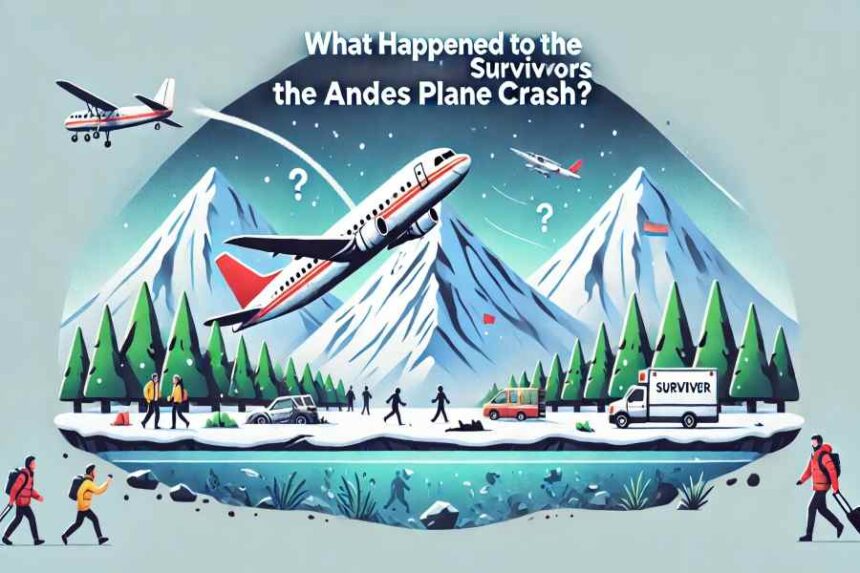The Andes plane crash, also known as the 1972 Andes flight disaster, remains one of the most harrowing survival stories in history. On October 13, 1972, a Uruguayan Air Force Fairchild FH-227D crashed into the Andes mountains, carrying 45 passengers and crew members, including a rugby team. The following ordeal tested the limits of human endurance, willpower, and resilience. What happened to the survivors of the Andes plane crash is a tale of extraordinary courage and determination. This article delves into their experiences, challenges, and how they survived against all odds. Through this comprehensive account, we aim to answer the lingering questions about the fate of these brave individuals.
What happened to the survivors of the Andes plane crash?
The survivors of the Andes plane crash faced unimaginable challenges after their aircraft went down in the mountains in 1972. Initially, 45 people were on board, but only 16 survived. They endured extreme cold, avalanches, and injuries. The most controversial aspect of their survival was resorting to cannibalism, consuming the bodies of deceased passengers to stay alive. After 72 days, two of the survivors trekked for ten days to find help, leading to the rescue of the remaining survivors. Their story is a testament to human resilience and the will to survive against all odds.
The Initial Impact And Immediate Aftermath
The crash of the Fairchild FH-227D on October 13, 1972, was a devastating event that left the survivors in shock and disbelief. The impact killed several passengers instantly, and many more were severely injured. In the immediate aftermath, those who could move began to tend to the wounded and assess their dire situation. The survivors quickly realized they were in an extremely remote area with little hope of immediate rescue.
Despite their dire circumstances, the survivors displayed remarkable resilience. They used the plane’s wreckage to create makeshift shelters and searched for supplies to aid their survival. The cold was relentless, and they had to rely on their resourcefulness to keep warm without proper clothing. The group rationed their little food, but it soon became clear that these supplies would not last long.
As days turned into weeks, the survivors faced the grim reality of their situation. Rescue missions were called off after several days, and the survivors were presumed dead. The group had to come to terms with the fact that they were entirely on their own. This realization prompted them to take drastic measures to stay alive.
One of the most challenging decisions the survivors faced was the need to consume the bodies of those who had perished. This decision was not taken lightly, but it became a matter of life and death. The survivors later described this act as a necessary evil to ensure their survival. This controversial aspect of their story has been a point of fascination and horror for many, but it underscores the extreme conditions they endured.
The survivors also had to contend with avalanches and harsh weather conditions. These natural threats claimed more lives and added to the group’s desperation. Despite these challenges, the survivors continued to hold on to hope and maintained a sense of solidarity. Their determination to stay alive kept them going even when the odds seemed insurmountable.
The Journey To Find Help
The decision to Seek Help: After weeks of waiting for a rescue that never came, the survivors realized they had to take matters into their own hands. A decision was made for a small group to trek through the Andes in search of help. This group included Nando Parrado and Roberto Canessa, who volunteered for the perilous journey.
Preparing for the Trek: The survivors prepared for the trek by gathering the limited resources they had. They created makeshift sleeping bags from airplane insulation and clothing to protect themselves from the freezing temperatures. They also carried small amounts of food, knowing it would not be enough but hoping to find more.
The Trek Through the Andes: The journey through the Andes was grueling and dangerous. Parrado and Canessa faced extreme cold, treacherous terrain, and the constant threat of avalanches. Despite these challenges, they pressed on, driven by the hope of saving their friends. After ten days of arduous travel, they finally encountered a Chilean shepherd who helped them reach civilization.
The Rescue Mission: Once Parrado and Canessa reached safety, a rescue mission was quickly organized. On December 20, 1972, helicopters were dispatched to the crash site. The remaining survivors were finally rescued, ending their 72-day ordeal in the mountains. The rescue was a moment of immense relief and joy for the survivors and their families.
Aftermath and Reflection: The survivors’ return to society was met with relief and curiosity. Their story of survival captivated the world, and they became the subjects of intense media scrutiny. The ordeal left deep emotional and physical scars, but it also forged a strong bond among the survivors. They have since shared their story through books, documentaries, and interviews, highlighting the resilience of the human spirit.
The Legacy Of The Andes Plane Crash
- The legacy of the Andes plane crash extends far beyond the immediate survival story. It has left an indelible mark on aviation safety, survival psychology, and popular culture. The crash prompted significant changes in aviation safety protocols, particularly concerning emergency responses and search and rescue operations.
- In survival psychology, the Andes crash is often cited as a case study in extreme human resilience and decision-making under duress. Researchers and psychologists have studied the survivors’ experiences to understand better how humans cope with life-threatening situations. The crash has provided valuable insights into survival scenarios’ mental and emotional processes.
- The story of the Andes plane crash has also permeated popular culture. Numerous books, documentaries, and films have been made about the incident, highlighting different aspects of the survivors’ ordeal. The 1993 film “Alive,” based on the book by Piers Paul Read, brought the story to a global audience and remains one of the most well-known adaptations.
- The survivors themselves have played a crucial role in preserving the crash’s legacy. Many have written books and given talks about their experiences, sharing their stories of courage and perseverance. Their firsthand accounts have provided an intimate and authentic perspective on the events, contributing to the lasting impact of their stories.
Lessons Learned From The Andes Plane Crash
Importance of Preparedness
The crash underscored the importance of preparedness in aviation. Emergency kits, survival training, and effective communication systems are now considered essential flight safety components. The incident led to stricter safety measures to prevent similar tragedies.
Human Resilience and Adaptability
The story of the Andes survivors is a testament to human resilience and adaptability. Faced with seemingly insurmountable odds, they demonstrated extraordinary resourcefulness and determination. Their ability to adapt to their environment and make difficult decisions was key to their survival.
Ethical and Moral Challenges
The ethical and moral challenges faced by the survivors, particularly their decision to resort to cannibalism, highlight the complexities of survival in extreme conditions. This aspect of their story has sparked widespread discussion and debate, offering important lessons about the boundaries of human behavior in life-and-death situations.
Community and Support
The sense of community and support among the survivors was crucial to their endurance. Their solidarity and mutual aid provided emotional strength and practical assistance. This highlights the importance of social bonds and teamwork in overcoming adversity.
Continuing the Legacy
The survivors’ efforts to share their stories have ensured that the lessons learned from the Andes plane crash continue to resonate. Their books, talks, and interviews have contributed to a broader understanding of survival and resilience. Their legacy is an enduring reminder of the human spirit’s capacity to overcome even the most extreme challenges.
Final Words
The story of what happened to the survivors of the Andes plane crash is a profound testament to human resilience, courage, and the will to survive. From the immediate aftermath of the crash to the harrowing decisions made to stay alive, the survivors demonstrated extraordinary strength. Their experiences have provided valuable lessons in aviation safety, survival psychology, and the power of the human spirit. As we reflect on their journey, we are reminded of the enduring impact of their story and the legacy they have left behind.
FAQ’s
How did the survivors finally get rescued?
Two survivors, Nando Parrado and Roberto Canessa, trekked for ten days through the Andes to find help, leading to the rescue of the remaining survivors.
What impact did the Andes plane crash have on aviation safety?
The crash led to significant changes in aviation safety protocols, particularly regarding emergency responses and search and rescue operations.
How have the survivors contributed to preserving the legacy of the crash?
The survivors have written books, given talks, and participated in documentaries, sharing their experiences and lessons learned from the ordeal.




